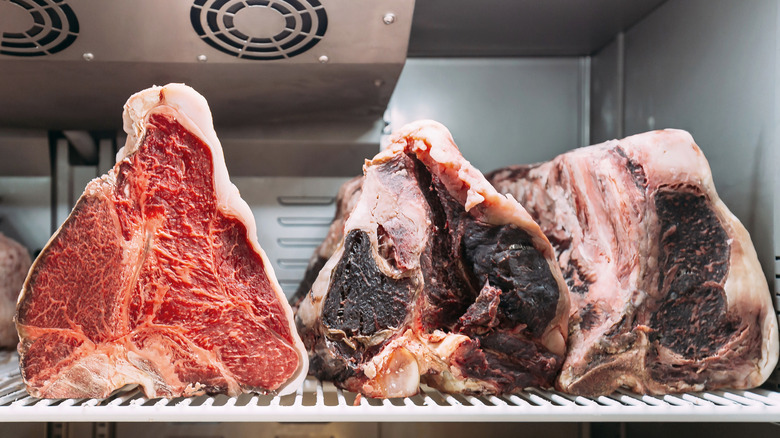Why You Shouldn't Add Fat Before Dry-Aging Your Steak
Dry-aging your steak is a sure-fire way to ensure it has optimal juiciness and flavor. Basically, this process uses cold temperatures to tenderize the meat via natural enzymatic reactions while removing excess moisture for a rich, concentrated taste. Though it's common to add a generous helping of salt to the exterior before exposing the meat to refrigerated temperatures for weeks, Jon Urbana, founder of the American Wagyu delivery service KOW Steaks, says it's best not to add any fat to the equation. "When it comes to dry-aging, less is more," the steak expert reveals. "You don't want to season or coat the meat with fat before aging."
One key to dry-aging beef is removing water from the steak so the natural flavors and fats can shine. Since fat is hydrophobic, it doesn't readily mix with water. Meaning, when you add fat like butter or oil to the outside of the steak, it blocks moisture release and slows down the dry-aging process. Though dry-aging enhances the natural flavors of the meat as it is, there are ways to amplify the meat's taste during the aging process without added fats.
"In professional dry-aging environments, specific molds are often introduced intentionally," Urbana explains, adding that many add mold to "help grow beneficial bacteria that naturally enhance tenderness and flavor over time." This can add uniquely buttery, nutty characteristics to the steak, making the need for butter and other flavorful cooking ingredients less necessary.
For the best dry-aged beef, focus on the process
Adding natural bacteria to dry-aged steak creates an exterior coating, which prevents spoilage and also helps impart flavor. However, you can certainly try your hand at the steak method simply using salt, cooling techniques, and natural enzymatic reactions (sans added bacteria). This will lead to enhanced natural tastes of the beef but won't be as complex as methods that introduce bacteria. Whether you add natural bacteria and mold like lactic acid or penicillium to the meat is up to you. However, Urbana notes, "The real key is controlling humidity, temperature, and airflow to deliver consistent, high-quality results."
So, you can let the dry-aging process speak for itself and focus on getting your aging parameters in check. That includes fan positioning and space in your refrigerator with plenty of air flow. While it's best to avoid adding fat during the dry-aging process, if you really want to add butter, add it in after the meat has been dry-aged, right before roasting or grilling the steak.
For restaurant-worthy dry-aged steak, it also helps to get to know different cuts of meat and their uses in cooking. For instance, thick cuts of steak like strip, ribeye, and sirloin, which contain lots of marbling, work best for dry-aging since it will enhance the meat's fattiness. Just remember, dry-aged steak is usually pricey due to the time and attention it requires — so practice patience as you try dry-aging steaks at home.

